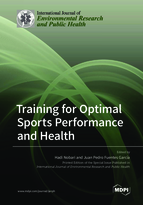Training for Optimal Sports Performance and Health
A special issue of International Journal of Environmental Research and Public Health (ISSN 1660-4601). This special issue belongs to the section "Exercise and Health".
Deadline for manuscript submissions: closed (31 May 2022) | Viewed by 66575
Special Issue Editors
2. HEME Research Group, Faculty of Sport Sciences, University of Extremadura, 10003 Cáceres, Spain
3. Department of Exercise Physiology, Faculty of Sport Sciences, University of Isfahan, Isfahan 81746-7344, Iran
4. Sports Scientist, Sepahan Football Club, Isfahan 81887-78473, Iran
Interests: sports performance; growth of youth and maturation; external load monitoring; training load; well-being; soccer training; injury prevention; strength and conditioning; sports nutrition and supplement; quality of life; reliability; validity of devices
* Sports Scientist of Sepahan Football Club
Special Issues, Collections and Topics in MDPI journals
Interests: psychophysiology; heart rate variability; EEG; exercise; stress management; biofeedback; neurofeedback
Special Issues, Collections and Topics in MDPI journals
Special Issue Information
Dear Colleagues,
We are delighted to invite you to contribute to this Special Issue of International Journal of Environmental Research and Public Health, which is titled "Training for Optimal Sports Performance and Health” .
A complete and regular set of different areas of sports science are required to achieve optimal sports performance. Exercise physiology is one of the most important and practical fields in sport science that provide information for strength and conditioning coaches in sports teams. For this reason, identifying the physical demands of sports must be a priority for professional coaches. Each sport differs in its physical demands, with a wide range of skills at varying levels of intensity. Athletes are primarily involved in kinds of running, kicking, jumping, sprinting, and changing of direction; these physical abilities require maximum strength, maximal oxygen uptake, anaerobic power, and the neuromuscular system. In order for athletes and sports teams to achieve optimal performance in these physical indicators, the coach must be able to do several things for the athletes and their teams, including the following: (i) fitness assessments—step-by-step evaluations of athletes in different training phases in the competition season and pre-season; (ii) conditioning specific for sports—this means a variety of exercises for running at different speeds, acceleration, deceleration, and exercises in simulated field conditions such as small sided game (SSG); (iii) strength training—this section should include a set of resistance exercises, including weight training, dumbbells, barbells, and functional training; (iv) explosive power, speed, and change of direction development—at this stage, the correct techniques of jumping with one and a pair of legs, jumping on different boxes, sled run, band resisted running, and agility ladders drills; (v) and, almost the most important part that should be prioritized by coaches in all training seasons, is to be able to manage the training load, recovery between training sessions and match, injury prevention, and rehabilitation of players through monitoring, which can be of external load to all types of running, metabolic power, and body load, internal load to the rating of perceived exertion or heart rate and, finally, the well-being status of players using various tools such as the Hooper index questionnaire.
Therefore, the aim of this Special Issue is to identify the training strategies to achieve the desired performance in competitions for athletes, individually or as a team and considering different ages and sports, which can (1) be considered and studied as periodization and programming for training in different periods of the season; (2) keep or lead the athlete to the desired performance by managing the training load; (3) monitor the athlete’s wellness status for preventing the development of over-training syndrome and non-functional overreaching statuses as well as to achieve the desired performance and prevent performance distortion; (4) quantify the relationship between fitness assessments with training loads and well-being status; and (5) examine the role of different types of training such as SSG, agility, speed, and resistance training in different age groups in different teams.
We eagerly anticipate your sensational papers!
Dr. Hadi Nobari
Prof. Dr. Juan Pedro Fuentes García
Guest Editors
Manuscript Submission Information
Manuscripts should be submitted online at www.mdpi.com by registering and logging in to this website. Once you are registered, click here to go to the submission form. Manuscripts can be submitted until the deadline. All submissions that pass pre-check are peer-reviewed. Accepted papers will be published continuously in the journal (as soon as accepted) and will be listed together on the special issue website. Research articles, review articles as well as short communications are invited. For planned papers, a title and short abstract (about 100 words) can be sent to the Editorial Office for announcement on this website.
Submitted manuscripts should not have been published previously, nor be under consideration for publication elsewhere (except conference proceedings papers). All manuscripts are thoroughly refereed through a single-blind peer-review process. A guide for authors and other relevant information for submission of manuscripts is available on the Instructions for Authors page. International Journal of Environmental Research and Public Health is an international peer-reviewed open access monthly journal published by MDPI.
Please visit the Instructions for Authors page before submitting a manuscript. The Article Processing Charge (APC) for publication in this open access journal is 2500 CHF (Swiss Francs). Submitted papers should be well formatted and use good English. Authors may use MDPI's English editing service prior to publication or during author revisions.
Keywords
- athletes
- elite
- external load
- functional training
- fitness assessments
- GPS
- HIIT
- injury
- internal load
- monitoring
- NFOR
- soccer
- sports
- speed
- SSG
- s-RPE
- prevention
- performance
- periodization
- professional
- resistance training
- RPE
- training load
- youth
- well-being
- workload







